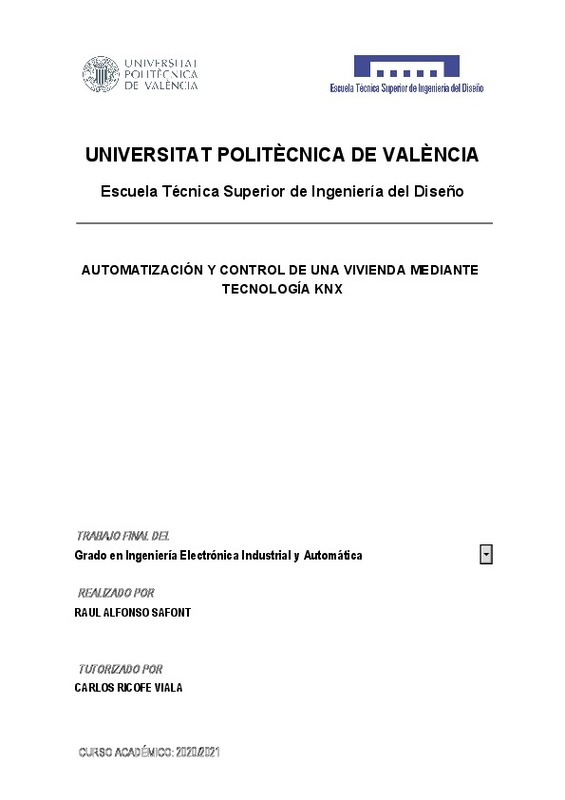JavaScript is disabled for your browser. Some features of this site may not work without it.
Buscar en RiuNet
Listar
Mi cuenta
Estadísticas
Ayuda RiuNet
Admin. UPV
Automatización y control de una vivienda mediante tecnología KNX
Mostrar el registro sencillo del ítem
Ficheros en el ítem
| dc.contributor.advisor | Ricolfe Viala, Carlos
|
es_ES |
| dc.contributor.author | Alfonso Safont, Raúl
|
es_ES |
| dc.date.accessioned | 2021-07-26T14:39:37Z | |
| dc.date.available | 2021-07-26T14:39:37Z | |
| dc.date.created | 2021-07-07 | |
| dc.date.issued | 2021-07-26 | es_ES |
| dc.identifier.uri | http://hdl.handle.net/10251/170208 | |
| dc.description.abstract | [ES] En este proyecto, se va a realizar la domotización de una vivienda familiar, donde se desarrollara las necesidades reales de una vivienda, materiales necesarios para el control y su posterior automatización. Dicha vivienda, se encuentra actualmente en construcción, por lo que se realizará el control y su correspondiente comprobación mediante una simulación. Para esta domotización, se utilizará el software ETS para la configuración y programación de los diferentes dispositivos. Mediante este software se realizará también la configuración de las diferentes direcciones de grupo que permitirán actuar sobre nuestros dispositivos y su posterior asignación a su actuador correspondiente. La programación consistirá en el control automático tanto de luces de regulación mediante actuadores DALI, suelo radiante mediante actuador de calefacción, luces binarias a través de actuadores de conexión binarios, persianas, lamas, foscurit y cortinas a través de actuadores de persianas, así como de la temperatura mediante sensores de temperatura. Todo ello controlado a través de los diferentes interruptores. También se realizará matrices de pulsadores para poder saber con exactitud mediante que pulsadores activamos los diferentes actuadores. Para su posterior instalación, se realiza los esquemas de los cuadros de control a través de herramientas de CAD, donde se mostrará todas las conexiones KNX. De manera análoga, se realiza la programación de las distintas pantallas de la vivienda mediante la aplicación remota de Schneider Electric, estas se utilizan como interfaz de usuario, donde permitirán controlar todos los actuadores de la vivienda. Para esta interfaz se utilizará esquemas de las habitaciones de la vivienda con sus diferentes interruptores, pulsadores y sensores. Con el fin de ilustrar el correcto funcionamiento de los distintos interruptores y actuadores, se realizara una simulación a través de las pantallas. Para finalizar, se realiza los planos de la vivienda, así como un presupuesto del proyecto y sus correspondientes condiciones técnicas. Así como un manual de usuario que permitirá conocer todas las funciones realizadas en las pantallas. | es_ES |
| dc.description.abstract | [EN] In this project, the automation of a house will be undertaken. During its development, I will consider the real needs of the house and the required materials for its control and later implementation. The house object of the project is actually under constructions, so all the required tests will be realized through simulation. In this automation I will use the ETS software for the configuration and programming of all the devices. Using this software, I will also perform the configuration of the group policies which will allow to take action on the devices, and their subsequent assignment to their corresponding actuator. The programming will consists of the automatic control of dimming lights through DALI actuators, radiant floor control through heating system actuators, binary lights control through binary actuators, blinds and curtains control through blinds actuators, in addition to temperature control through temperature sensors. All this devices controlled by their respective switches. Button arrays will be also performed to know exactly the needed buttons to activate each actuator. For later installation, the electrical circuit diagram will be realized using CAD tools. This diagram shows all the KNX conections. Likewise, the programming of the different displays of the house will be performed using the Schneider Electric remote application. This displays will be used as a user interface, where the user will control all the actuators of the house. In this interface I will use room schemes with all the switches, buttons and sensors. In order to ilustrate the operation of the different devices, a simulation will be realized through the display. Finally, I will make the house plans as well as a quotation of the project with their corresponding technical conditions. I also will develop an user manual which describe all the functions the can be perfomed on the displays. | es_ES |
| dc.format.extent | 375 | es_ES |
| dc.language | Español | es_ES |
| dc.publisher | Universitat Politècnica de València | es_ES |
| dc.rights | Reserva de todos los derechos | es_ES |
| dc.subject | Automatización | es_ES |
| dc.subject | Vivienda | es_ES |
| dc.subject | Domótica | es_ES |
| dc.subject | Control | es_ES |
| dc.subject | Actuadores. | es_ES |
| dc.subject | Automation | es_ES |
| dc.subject | Actuators | es_ES |
| dc.subject.classification | INGENIERIA DE SISTEMAS Y AUTOMATICA | es_ES |
| dc.subject.other | Grado en Ingeniería Electrónica Industrial y Automática-Grau en Enginyeria Electrònica Industrial i Automàtica | es_ES |
| dc.title | Automatización y control de una vivienda mediante tecnología KNX | es_ES |
| dc.type | Proyecto/Trabajo fin de carrera/grado | es_ES |
| dc.rights.accessRights | Abierto | es_ES |
| dc.contributor.affiliation | Universitat Politècnica de València. Departamento de Ingeniería de Sistemas y Automática - Departament d'Enginyeria de Sistemes i Automàtica | es_ES |
| dc.contributor.affiliation | Universitat Politècnica de València. Escuela Técnica Superior de Ingeniería del Diseño - Escola Tècnica Superior d'Enginyeria del Disseny | es_ES |
| dc.description.bibliographicCitation | Alfonso Safont, R. (2021). Automatización y control de una vivienda mediante tecnología KNX. Universitat Politècnica de València. http://hdl.handle.net/10251/170208 | es_ES |
| dc.description.accrualMethod | TFGM | es_ES |
| dc.relation.pasarela | TFGM\144864 | es_ES |
Este ítem aparece en la(s) siguiente(s) colección(ones)
-
ETSID - Trabajos académicos [8898]
Escuela Técnica Superior de Ingeniería del Diseño






